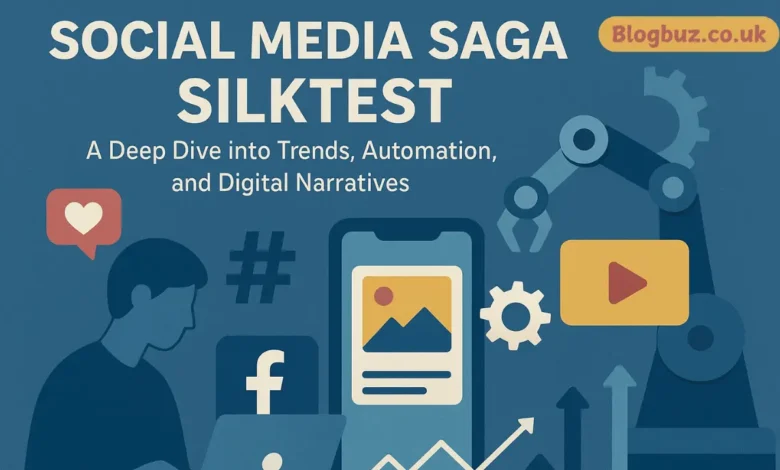Social Media Saga SilkTest: A Deep Dive into Trends, Automation, and Digital Narratives

In today’s fast-moving digital landscape, new terms and phrases often gain traction through blogs, forums, and social conversations. One such phrase making its way into online discussions is Social Media Saga SilkTest. While not an official product or feature, this phrase represents the convergence of two important domains: the social media saga—the evolving story of platforms, trends, and digital culture—and Silk Test (SilkTest), a longstanding automation tool used for testing applications. This deep dive will explore how social media narratives interact with testing technologies like SilkTest, why this phrase has emerged as a trending keyword, and what it means for businesses, developers, and content creators in 2025 and beyond.
Understanding the Social Media Saga
Social media has transformed into a saga—an unfolding story that reflects society, culture, politics, and business. From the rise of Facebook in the 2000s to TikTok’s current global dominance, every platform contributes a new chapter to this saga. Key aspects of the social media saga include:
- Shifting Platforms: Users migrate between platforms as trends evolve—such as Instagram Reels, YouTube Shorts, X (formerly Twitter) updates, and LinkedIn thought leadership.
- Algorithmic Influence: What people see, like, and share is primarily determined by complex recommendation engines.
- Narrative Power: Viral challenges, memes, and influencer storytelling can significantly impact brand reputations in a matter of days.
- Data & Privacy Concerns: Each platform adds layers to the narrative around how data is collected, shared, and monetized.
The saga isn’t just about technology—it’s about human behavior and the art of digital storytelling.
Introducing SilkTest: A Pioneer in Test Automation
While the Social Media Saga SilkTest may sound like a new digital buzzword, the SilkTest tool itself has a well-established history in the tech industry. Initially developed by Segue Software in the 1990s, SilkTest has been a trusted framework for automating functional and regression testing across desktop, web, and mobile platforms.
Core Features of SilkTest
- Cross-platform support: Enables testing for Windows, Java, .NET, web, and mobile apps.
- Multiple scripting environments: Includes SilkTest Classic (4Test language) and Silk Test Workbench (VB.NET).
- Data-driven testing: Automates repetitive test cases with variable inputs.
- Integration capabilities: Works with CI/CD pipelines and modern dev tools.
This makes SilkTest a pioneer in ensuring quality assurance (QA)—long before Selenium, Appium, and Playwright became mainstream.
Where the Two Worlds Meet: Social Media Saga + SilkTest
So how does a test automation framework connect with the evolving narrative of social media? The intersection lies in automation and analysis.
- Testing Social Media Interfaces:
- With platforms like Facebook, Instagram, and Twitter offering APIs and web interfaces, automated tools such as SilkTest can simulate logins, post content, and validate feeds.
- Studying Algorithmic Behavior:
- Developers and researchers use test automation to simulate multiple user behaviors, tracking how platforms recommend posts, videos, or ads.
- Ensuring Consistent Branding:
- For businesses, automated testing ensures that brand elements (logos, text formats, CTAs) display consistently across mobile and desktop versions of social platforms.
- Experimentation with Narratives:
- The “saga” of social media can be studied through automated runs, measuring how different narratives perform, which hashtags trend, and how visual content scales.
In short, SilkTest provides a technical lens to examine and interact with the social media saga.
The Rise of the Social Media Saga SilkTest Online
During mid-2025, several blogs, SEO platforms, and digital news outlets began using the Social Media Saga SilkTest. It started as a tag on blogs that track emerging social media trends, but quickly grew into a content keyword cluster.
Reasons for its rise include:
- SEO-driven publishing: Websites began using the phrase to attract clicks on trending tech and social stories.
- Experimentation by developers: Some devs showcased SilkTest scripts running against social media feeds to uncover algorithmic biases.
- Narrative branding: Content creators leveraged the dramatic “saga” framing to tell stories about automation, AI, and digital transformation.
While the phrase may not denote a single product, it reflects a fusion of technology and a narrative that is meaningful to both technical and non-technical audiences.
Automation in the Age of Digital Narratives
One of the core implications of Social Media Saga SilkTest is how automation shapes stories. Social media thrives on virality, timing, and consistency—all areas where automation helps.
- Content Scheduling: Automated posting tools ensure brand narratives unfold at the right time.
- Sentiment Analysis: Automated scripts (often in Python or R) process millions of posts to gauge audience reactions.
- A/B Testing Narratives: Automation enables brands to test multiple story angles—such as humor, urgency, and emotional appeal—and see which one gains traction.
- Cross-platform consistency: Ensuring that a single campaign runs smoothly across Twitter, TikTok, Instagram, and YouTube.
SilkTest itself may not be a social media tool, but it symbolizes the broader movement of automation shaping digital stories.
Challenges at the Intersection of Automation and Social Media
While exciting, blending test automation with social narratives raises some challenges:
- Platform Restrictions: Social platforms often update APIs or block automated scripts to prevent spam.
- Ethical Concerns: Automated interactions may distort authentic engagement.
- Data Privacy: Collecting and testing user-driven data necessitates adherence to regulations such as the GDPR and CCPA.
- Tool Limitations: Legacy automation tools, such as SilkTest, may require adaptations to handle rapidly changing web technologies (e.g., React, Angular) frontend frameworks.
These challenges make it clear that automation should augment human creativity, not replace it.
The Future of Social Media Saga SilkTest
Looking forward, the Social Media Saga SilkTest may evolve into a shorthand for discussing how automation intersects with digital storytelling. As generative AI, automation frameworks, and algorithmic feeds continue to advance, businesses and developers will:
- Adopt hybrid automation frameworks (e.g., Playwright + AI-driven QA) to study platforms.
- Leverage narrative analytics to refine digital marketing strategies.
- Focus on ethical automation to maintain trust with users.
- Explore cross-industry use cases, from testing e-commerce checkout flows on Instagram to measuring ad placement reliability.
This suggests that the phrase may persist as an SEO keyword cluster representing broader trends in automation, testing, and digital narratives.
Conclusion: Navigating the Saga with Automation
The Social Media Saga SilkTest may not represent an official product. Still, it encapsulates something bigger: the intersection of ever-changing digital narratives and the automation frameworks that help us understand them. SilkTest, as a pioneer in automated testing, serves as a perfect symbolic anchor for discussing how automation enables brands, developers, and researchers to decipher the complexities of social platforms.
You May Also Read: From the FeedbackMagazineOrg: Redefining Digital Media with Insights, Engagement, and Innovation




